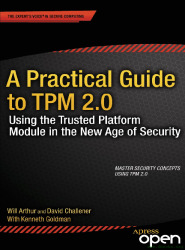A Practical Guide to TPM 2.0
Simply put, this book is designed to empower and excite the programming community to go out and do cool things with the TPM. The approach is to ramp the reader up quickly and keep their interest.A Practical Guide to TPM 2.0: Using the Trusted Platform Module in the New Age of Security explains security concepts, describes the TPM 2.0 architecture, and provides code and pseudo-code examples in parallel, from very simple concepts and code to highly complex concepts and pseudo-code.
The book includes instructions for the available execution environments and real code examples to get readers up and talking to the TPM quickly. The authors then help the users expand on that with pseudo-code descriptions of useful applications using the TPM.
Table of contents
- History of the TPM
- Basic Security Concepts
- Quick Tutorial on TPM 2.0
- Existing Applications That Use TPMs
- Navigating the Specification
- Execution Environment
- TPM Software Stack
- TPM Entities
- Hierarchies
- Keys
- NV Indexes
- Platform Configuration Registers
- Authorizations and Sessions
- Extended Authorization (EA) Policies
- Key Management
- Auditing TPM Commands
- Decrypt/Encrypt Sessions
- Context Management
- Startup, Shutdown, and Provisioning
- Debugging
- Solving Bigger Problems with the TPM 2.0
- Platform Security Technologies That Use TPM 2.0
| Pages : | 375 |
| Size : | 5.4 MB |
| File type : | |
| Downloads: | 119 |
| Created: | 2022-02-01 |
| License: | CC BY-NC-ND |
| Author(s): | by Will Arthur, David Challener, Kenneth Goldman |

Warning: Trying to access array offset on false in /home/tutovnfz/public_html/article.php on line 233
Others Computer science Tutorials
97 Things Every Software Architect Should Know
Others related eBooks about A Practical Guide to TPM 2.0
AutoCAD : Setting Up a DrawingDownload pdf tutorials about AutoCAD,this document is aimed at beginner looking to learn the basics of Setting Up an AutoCAD drawing....
A Problem Course in Mathematical LogicA Problem Course in Mathematical Logic is intended to serve as the text for an introduction to mathematical logic for undergraduates with some mathematical sophistication. It supplies definitions, statements of results, and problems, along with some explanations, examples, and hints. The idea is for...
Introduction to ProbabilityThe book is a beautiful introduction to probability theory at the beginning level. The book contains a lot of examples and an easy development of theory without any sacrifice of rigor, keeping the abstraction to a minimal level. It is indeed a valuable addition to the study of probability theory....
Enhanced Living EnvironmentsDownload free course Enhanced Living Environments, pdf file on 339 pages by Ivan Ganchev, Nuno Garcia, Ciprian Dobre, Constandinos Mavromoustakis, Rossitza Goleva....
LaTeX in 24 HoursDownload free course LaTeX in 24 Hours, pdf file on 309 pages by Dilip Datta....
Automated Machine LearningThis book presents the first comprehensive overview of general methods in Automated Machin..., download free Machine Learning tutorial in PDF (220 pages) created by Frank Hutter ....
Blazor SuccinctlyDownload free course Blazor Succinctly, pdf file on 86 pages by by Michael Washington....
Learning VimDownload free course Learning Vim, pdf file on 157 pages by Stack Overflow Community....
Signal ComputingDownload free course Signal Computing, pdf file on 207 pages by Michael Stiber, Bilin Zhang Stiber, Eric C. Larson....
Node.js Notes for ProfessionalsDownload free course Node.js Notes for Professionals, pdf file on 333 pages by Stack Overflow Community....